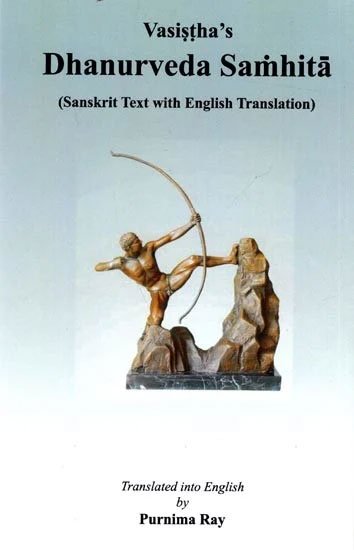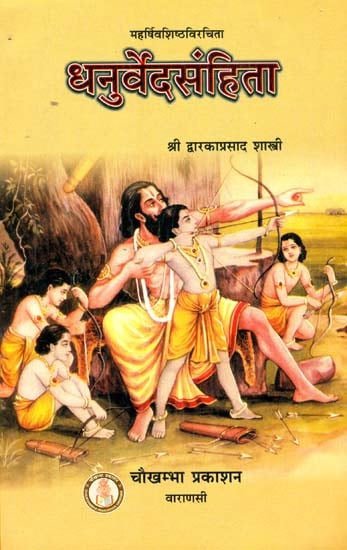Dhanurveda Samhita [sanskrit]
3,015 words
The Sanskrit text of the Dhanurveda-samhita attributed to Vasishtha. Dhanur Veda is a type of ancient India science whose roots date to the 2nd millenium BCE. It is counted among the Upavedas literature. This specific version of the Dhanurveda contains roughly 240 sections of Sanskrit text.
Verse 2.33d
तृतीयैकादश्यां तृतीयेऽर्द्धूयामे तमः ।
संमिलिता पार्वती याम्यां परिभ्रमति ॥ ३३द् ॥
tṛtīyaikādaśyāṃ tṛtīye'rddhūyāme tamaḥ |
saṃmilitā pārvatī yāmyāṃ paribhramati || 33d ||
Note! The following is not a translation of the above verse, but merely an arbitrary extract of the English text.
On the third and eleventh days of the month there is darkness. The goddess Parvati, who is united with the Lord, moves about in the south. 33d. ॥
English translation by Hardayalu Swami (2001) Buy now!
Glossary of Sanskrit terms
Note: This extracts Sanskrit terms and links to English definitions from the glossary, based on an experimental segmentation of verse (2.33d). Some terms could be superfluous while some might not be mentioned. Click on the word to show English definitions.
Tritiya, Ekadashi, Tama, Tamas, Milita, Parvati, Yami, Yamya, Paribhramat,
Analysis of Sanskrit grammar
Note: this is an experimental feature and only shows the first possible analysis of the Sanskrit text (Verse 2.33d). If the system was successful in segmenting the sentence, you will see of which words it is made up of, generally consisting of Nouns, Pronouns, Verbs, Participles and Indeclinables. Click on the link to show all possible derivations of the word.
- Line 1: “tṛtīyaikādaśyāṃ tṛtīye'rddhūyāme tamaḥ ”
- tṛtīyai -
-
tṛtīyā (indeclinable)[indeclinable]tṛtīya (indeclinable adverb)[indeclinable adverb]tṛtīya (noun, masculine)[compound], [vocative single]tṛtīya (noun, neuter)[compound], [vocative single]tṛtīyā (noun, feminine)[nominative single]
- ekādaśyām -
-
ekādaśī (noun, feminine)[locative single]
- Cannot analyse tṛtīye'rddhūyāme*ta
- tamaḥ -
-
tamas (noun, neuter)[compound], [nominative single], [vocative single], [accusative single]tama (noun, masculine)[nominative single]
- Line 2: “saṃmilitā pārvatī yāmyāṃ paribhramati || 33d |”
- saṃ -
-
sa (noun, neuter)[adverb], [nominative single], [accusative single]sam (Preverb)[Preverb]
- militā -
-
militā (noun, feminine)[nominative single]√mil -> militā (participle, feminine)[nominative single from √mil class 6 verb]√mil (verb class 6)[periphrastic-future active third single]
- pārvatī -
-
pārvatī (noun, feminine)[compound], [nominative single]pārvati (noun, masculine)[nominative dual], [vocative dual], [accusative dual]
- yāmyām -
-
yāmī (noun, feminine)[locative single]yāmyā (noun, feminine)[accusative single]yāmi (noun, feminine)[locative single]
- paribhramati -
-
paribhramat (noun, masculine)[locative single]paribhramat (noun, feminine)[locative single]paribhramat (noun, neuter)[locative single]
- Cannot analyse 33d
Other editions:
Also see the following editions of the Sanskrit text or (alternative) English translations of the Verse 2.33d
Dhanurveda Samhita (धनुर्वेदसंहिता)
by Hardayalu Swami (2001)
Publisher: Khemraj Shrikrishnadass
Buy now!
Vasistha’s Dhanurveda Samhita
by Purnima Ray (2023)
Publisher: Khemraj Shrikrishnadas; ISBN-10: 818670289X; ISBN-13: 9788186702895; 88 pages including 18 illustrations;
Buy now!
Dhanurveda Samhita (धनुर्वेदसंहिता) (संस्कृत एवं हिंदी अनुवाद)
by Shri Dwarka Prasad Shastri (2007)
Title: Dhanurveda Sanhita (Hindi translation); Publisher: Chaukhambha Prakashan, Varanasi; 84 pages including 11 illustrations; Author: महर्षि वशिष्ठ (Maharshi Vashistha); Foreword by Dr. Chakradhar Bijalwan.
Buy now!![Dhanurveda Samhita [sanskrit] - book cover](/uploads/a/Dhanurveda-Sanskrit.jpg)

